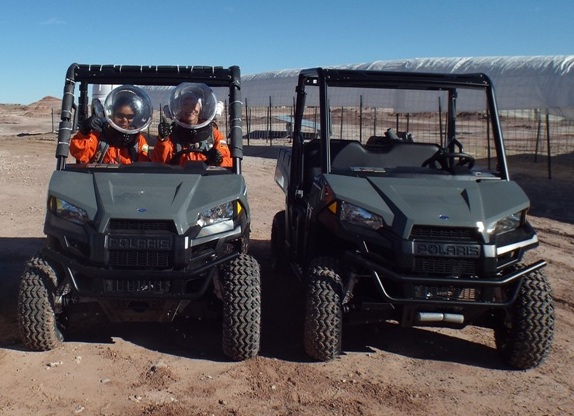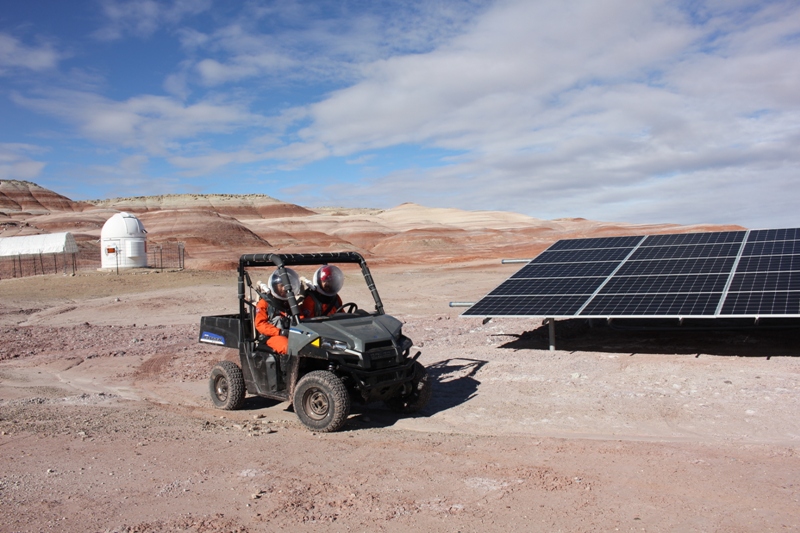Technology Report – December 8th
IDEAL UNPRESSURIZED ROVER
Jon Clarke

The twin rovers – Phobos and Deimos.
I have written before about the new electric rovers we have at MDRS. They are Polaris Ranger two seat 4WD vehicles, which have been named Phobos and Deimos, after the two moons of Mars. We have now had more experience with them and continue to be impressed. They are able to traverse all the tracks in the primary field area and have sufficient range to do so. Phobos has been fully modified to allow us to drive it while wearing simulated EVA suits. We can even wear seat belts while we are in the rovers, a considerable safety advantage. They are easy to operate, even by the most inexperienced. As previously noted it has good load carry capacity. Because they are electric they can be recharged from the station’s 15 kw solar array, once this is fully connected. Currently the science dome is run of the array, and soon we expect the rest of the station to be similarly connected, with a recharging kiosk for the two rovers.

Phobos and the new MDRS solar panels. Rechargeable solar power!
Phobos and Deimos are terrestrial counterparts to the Apollo Lunar Roving Vehicle, used with great effect by the crews of Apollos 15, 16, and 17. These vehicles allowed the astronauts on these missions to cover about 10 km of traverse on each of their EVAs on the moon, for a total of about 30 km per mission.

Apollo 17 Lunar Roving Vehicle (NASA).
Currently only Phobos is modified for use while suited, so backup is provided by the conventional quad bikes. Deimos will be converted in the near future. When both are converted, Deimos and Phobos together can provide effective mutual support for two or four person EVAs. This will allow more effective simulation of surface operations with equivalent vehicles on Mars (or the Moon for that matter).

Phobos rover –some might call it cramped, I call it cozy and effective.
Astronauts on Mars will almost certainly use small unpressurised vehicles similar to Phobos and Deimos for working at relatively short distances from the station. The exploration radius of sSingle vehicle EVAs will be constrained by the ability of the astronauts to walk back to the station in the event of the vehicle being immobilised. During the Apollo missions this was conservatively estimated at 5 km. Later, un-flown missions were expected to increase this distance to 10 or even 20 km. On Mars the current expectation is a walk back distance of 15 km, although this may be optimistic. Try hiking across county for 20 km with a 20 kg backpack to get a feel of what this might be like! This is probably a distance under ideal conditions, more realistic distances might be much closer to the station. However, using two such vehicles, each with one or two astronauts, would be able to provide mutual support on sorties of up to half a day’s drive from the station, which might be as far as 50 km with reasonable driving conditions. Depending on the landing site this might be enough to cover most if not all the regions of interest for an initial mission, avoiding the need for a heavy pressurised rover. This could be sent on a later mission if required.

Artist’s conception of an unpressurised rover on Mars (by David Hardy).
On Mars such vehicles could be fitted with a range of sensors to support crew EVAs such as video cameras, panoramic cameras, geophysical and surveying equipment, to name a few. In addition be being driven by astronauts they could potentially be remote controlled, or even operate semi-autonomously. Many of the necessary automation and teleoperation capabilities have already been tested for light military vehicles, such as the John Deere “R-Gator”. In addition to exploration they could be used to deploy solar arrays and power cables, carry out earth moving tasks (such as burying facilities, smoothing roads, excavating material for water extraction, and for scouting the landing site before the crew arrive. Unpressurised rovers could also be used to monitor sites of interest after the crew leave.

ToolCat light vehicle with earth moving attachments (Bobcat).
Another advantage of such vehicles is that they can be rapidly re-configured with a range of basic earth moving tools such as tip trays, buckets, and blades, much as their terrestrial counterparts already can. While not as efficient as specialised vehicles for such tasks (such as the Bobcat, familiar on building sites the world over), they will be more than good enough for initial Mars missions. Phobos and Deimos may indeed be the shape of things to come.



